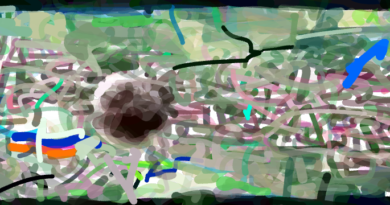The Ukraine Crisis Briefly Put America’s Culture War in Perspective

Late last month, the world watched in real time on social media as a nuclear power invaded a sovereign neighbor. In the days before Russian forces entered Ukraine, many high-profile commentators processed the impending crisis through the lens of America’s unending culture war. The left-wing contrarian Glenn Greenwald sneered that the CIA had told the media to use the term invasion, while the Fox News host Tucker Carlson implied that Russian President Vladimir Putin wasn’t as bad as American cancel culture. “Has Putin ever called me a racist?” Carlson wondered aloud. “Has he threatened to get me fired for disagreeing with him?” COVID-truther conspiracy theorists sagely pronounced the Russian military buildup a “wag the dog” moment, a “fabricated crisis” ginned up by elites pushing the “Great Reset,” a malicious gambit to redirect people’s attention away from truckers fighting vaccine tyranny.
But then, on February 24, the invasion began. On American social networks, where the culture war normally rages ceaselessly, the fights that tend to dominate online debate—such as the ones over COVID policies, school curriculums, and trans athletes—suddenly went quiet. This wasn’t for lack of effort; many hyperpartisan influencers tried to keep up their shtick. But the public’s attention appeared to be turning elsewhere. Data from CrowdTangle, a tool that tracks user engagement with Facebook content, suggested that many of the top posts among American users focused on the horrors and heroism of the conflict—families splitting up, Ukrainians volunteering to defend their country, a young soldier sacrificing himself to blow up a bridge. Although an imperfect metric, a top-10 list derived from CrowdTangle data—a ranking typically dominated by the most successful political rage content of the moment—suggested that, at least for a couple of days following the invasion, users were more engrossed in coverage of the breaking war.
Those first few days after Russia’s invasion revealed something important about the United States: Much of what looks like unbridgeable polarization online may be the product of boredom, distraction, and jadedness; when something real happens, people pay attention to that instead. We refresh our feeds incessantly, looking for new information and sharing it. And as a shooting war started, average users sought out experts and reputable news organizations. Google Trends, for example, showed a relative increase in searches for nuclear weapons and potassium iodide—a treatment used after radiation emergencies—while searches for Ukraine were at an all-time high. The culture war temporarily faded into the background—much as it did in the early days of 2020, when a new pathogen was still largely confined to China.
The vibe shift after the invasion of Ukraine began was so profound, many Twitter users assumed that Russian trolls—so often blamed for the tumult of the online political debate since 2016—had suddenly been banished from American screens. This assumption fueled speculation: Maybe the trolls had been reassigned to focus on Ukraine, taken offline by Russia’s new social-media restrictions, or somehow bankrupted by the precipitous plunge of the ruble. “Please take note of how dramatically Twitter has changed since the freezing of Russian assets. Suddenly all those anti-Biden ‘American patriots’ have disappeared,” read one tweet that received more than 100,000 likes. Physicians with verified accounts noted that they were no longer being barraged by anti-vaccine, anti-mandate, or pseudoscience conspiracy theorists. One observed that Google search trends showed a relative decline in interest in myocarditis and ivermectin; he, too, went on to speculate that “*most* of the COVID #misinformation is driven by Russian bots.” But bots aren’t the ones running internet searches about rare vaccine side effects or unproven COVID drugs.
In general, Americans have been too quick to blame Russian trolls for the degraded quality of online discourse. Residual anger about Russian interference in the 2016 U.S. presidential election has prompted many people, especially on the left, to attribute rancorous discussion to foreign agents hell-bent on dividing Americans. This story is comforting; it implies that the fault lies somewhere other than with our fellow citizens or ourselves.
Yet my team’s research at the Stanford Internet Observatory suggests that the conspiracy theories pervading conversations about COVID or politics typically originate with Americans, and they spread because enough Americans want them to. Although some foreign agitators do play on the fringe of some hashtags, they are seldom the primary drivers in the public conversation. If flooding social media with propaganda is an act of aggression, Americans are our own worst enemy.
As the invasion of Ukraine loomed, pro-Moscow social-media accounts kept busy—but not with trying to get Americans to fight over mask mandates or cancel culture. Russian online propagandists had a more specific job to do. In early February, Russia attempted to lay a foundation for impending action, inflecting its claims for specific audiences on particular platforms. As it had done in conflicts past, it produced information campaigns for its domestic population, citizens of its immediate adversary, and far-afield observers, including audiences in the West, using a combination of state media and fake accounts in attempts to convince them of the righteousness of Putin’s cause as well as the perfidy and veritable Nazism of the “Ukrainian regime.”
But then, on February 24, the shooting war began, and the information war entered a different phase. Russian state-media accounts—and anonymous figures sharing similar stories on the messaging app Telegram—shifted topics. Rather than trying to shape Western public opinion about Ukraine, their content focused on creating confusion for audiences on or near the battlefield, undermining the morale of the Ukrainian people, and spreading rumors that the Ukrainian government had fled.
Meanwhile, on American social-media platforms, a groundswell of support for Ukraine began to dominate the information environment. The tone was set by video capturing the extraordinary courage of President Volodymyr Zelensky and scenes of incredible bravery by ordinary Ukrainian people—including a woman telling Russian soldiers to put sunflower seeds in their pockets so flowers would bloom after they died.
Some of this content, too, was quickly repurposed as propaganda; clips of heroic acts went viral, and rumors became myth. Fake clips proliferated, as the fog of war met the cyclone of content—scenes from video games were shared as footage of purported fighting—but cadres of debunkers and open-source-intelligence analysts enlisted in volunteer online armies, coordinating in Telegram channels, examining clips, and adding context. Even as a researcher accustomed to viral chaos, I couldn’t keep up at times with the flow of unverified Ukraine-related content—but not all of it was deceptive garbage.
For better or worse, the change in Americans’ viewing habits was not permanent. By early last week, the top-ranked posts on CrowdTangle were once again focused primarily on outrage-friendly stories—calls to fire Anthony Fauci, discussions of Jussie Smollett’s hate-crime hoax—mixed in with some heartwarming stories about dogs (both in Ukraine and in Alaska’s Iditarod race).
Interestingly, Russian state media seem to be looking westward again. When justifications of “denazification” flopped as a pretext for invasion, these outlets’ English-language accounts started talking up purported Ukrainian bioweapon labs supported by the Pentagon; Chinese state media began boosting the story too. But the Russians don’t need shadowy troll accounts to whisper about it on Twitter, because—predictably—prominent American culture-war influencers have taken the bait and aired the conspiracy theory on their own platforms. What was the U.S. government’s role in the biolabs, anyway?
Still, the early days of the Russian invasion showed that everyday users have choices. The American culture-war influencers didn’t disappear; users just didn’t pay as much attention to them. It shouldn’t take a shooting war to pull our eyeballs away from the culture war. The normal state of online discourse shouldn’t be an information war of all against all. The brief moment when Americans focused on more important things didn’t last, but it did show that we have some agency here.
This article has been archived for your research. The original version from The Atlantic can be found here.


